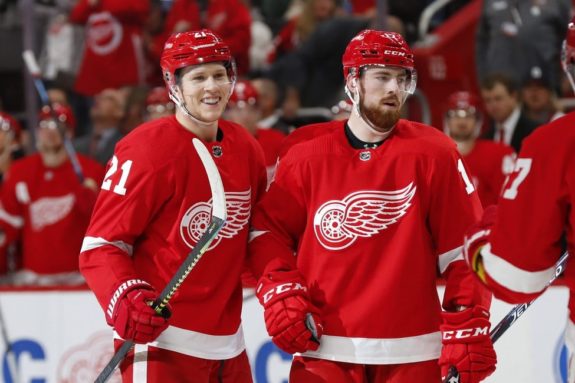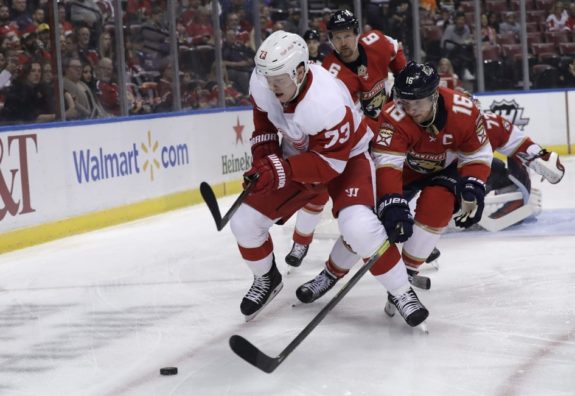With a record of 7-12-1 through 20 games, what should be made of the 2019-20 Detroit Red Wings?
It’s a simple question: How are the Red Wings doing? The answer, though, is a little more complicated. As a rebuilding team, Detroit’s record doesn’t accurately reflect their progress. However, a number of factors can help steer us in the right direction.
The Red Wings should be focused on developing their young core, achieving some level of consistency, and continuously learning throughout the season. These are arguably more important than wins and losses, especially if the organizational decree is to be patient.
Let’s take a look at how the Red Wings have fared with regard to these on-ice benchmarks through the quartermark of the 2019-20 campaign. First we’ll identify what we want to learn, then determine a handful of key performance indicators (KPIs) that can help answer those questions, and finally analyze how the Red Wings are doing so far this season using those metrics.
Are the Red Wings’ Young Players Getting Sufficient Ice Time?
KPIs: Five-on-five time on ice (5v5 TOI).
This one is easy – yes, the Red Wings’ young core is receiving adequate ice time for their development. Dylan Larkin, Anthony Mantha, Tyler Bertuzzi, and Andreas Athanasiou are the top-four forwards in terms of 5v5 TOI. In addition, Filip Hronek has been Detroit’s go-to defenseman, playing north of 17 minutes at even strength each night.

New acquisitions Adam Erne, Brendan Perlini, and the suddenly dangerous Robby Fabbri have all seen their 5v5 TOI increase since joining the Red Wings. The one knock against Detroit’s deployment, though, is that Dennis Cholowski ranks seventh among Red Wings defensemen in even-strength TOI per game (14:52).
Is Detroit’s Young Core Developing?
KPIs: Points per 60 (P/60); goals above replacement per 60 (GAR/60).
For the sake of this learning, we’ll take a look at just Larkin, Mantha, Bertuzzi, Athanasiou, and Hronek. First, P/GP through the first 20 games:
| Player | 2018-19 P/60 | 2019-20 P/60 | Increase/Decrease |
| Dylan Larkin | 2.64 | 2.12 | -19.70% |
| Anthony Mantha | 2.41 | 2.98 | +23.65% |
| Tyler Bertuzzi | 2.34 | 2.75 | +17.52% |
| Andreas Athanasiou | 2.51 | 1.83 | -27.09% |
| Filip Hronek | 1.50 | 1.33 | -11.33% |
Athanasiou, to no surprise, isn’t producing as strong of numbers as he did last season. However, he’s come on as of late, with six points in his last seven games.
Outside of the box score, how have these players performed? Let’s take a look at each players’ GAR/60. For those who are not already familiar with the stat, check out an overview here.
| Player | 2018-19 GAR/60 | 2019-20 GAR/60 | Increase/Decrease |
| Dylan Larkin | 0.343 | 1.180 | +244.02% |
| Anthony Mantha | 0.302 | 1.017 | +236.75% |
| Tyler Bertuzzi | 0.511 | 0.555 | +8.61% |
| Andreas Athanasiou | 0.379 | -0.266 | -170.18% |
| Filip Hronek | 0.148 | 0.358 | +141.89% |
Much like in the P/GP table, Athansiou’s decline shouldn’t be surprising. But it’s great to see the rest of Detroit’s core trending in a positive direction. Larkin, in particular, has looked like a true first-line center this season and the numbers back that up. He has roughly the same GAR/60 as David Pastrnak, Nathan McKinnon, and Leon Draisaitl according to Evolving-Hockey. Pretty good company, eh?
Are the Red Wings Consistently Sticking to the System?
KPIs: Close games; goals against per 60 (GA/60); expected goals against per 60 (xGA/60).
When the Red Wings are on their game, they’re fun to watch. When they’re not, … yikes.

Of Detroit’s first 20 games, you could argue that eight were ugly losses. Injuries and growing pains can be partially attributed, but when the Red Wings have the worst goal differential in the NHL (-29), that’s not good. That being said, how does this season’s team compare to the 2018-19 Red Wings?
- 2018-19: 3.27 GA/60; 3.21 xGA/60
- 2019-20: 3.77 GA/60; 3.23 xGA/60
A reflection of the shots they’re giving up, Detroit’s xGA isn’t very good and hasn’t improved from last season. However, Jimmy Howard and Jonathan Bernier aren’t doing the team any favors – they’ve given up half a goal more per 60 than they did during the 2018-19 season.
The goalies can’t shoulder the entire blame, though. Detroit’s defensive zone system is to minimize quality chances against. They aren’t doing that, as evidenced by the second-worst xGA/60 among all 31 NHL teams this season.
Are the Red Wings Learning and Adapting?
KPIs: Qualitative/anecdotal analysis.
Without insight into Jeff Blashill’s exact directives, this question is a little more difficult to address than the others. Anecdotally, the team hasn’t learned how to consistently rebound from goals against. They’re still committing far too many defensive zone turnovers. And they haven’t figured out special teams yet – especially the penalty kill.
“Our special teams have been killing us,” Justin Abdelkader told former THW contributor and current Sporting News writer Sammi Silbur following last week’s loss to the New York Rangers. “We continue to lose, especially [the special teams] battle, you’re not going to win a lot of games when you’re minus-3 in the special teams department it’ll be tough to win any games.”
Compared to last season, there hasn’t been much growth. It’s fair to say that the team is still learning how to learn, if that makes any sense. This is certainly something that should be reviewed at the end of the season. Where have the Red Wings improved? What areas got worse over the course of the season? What was done to address these components?
Final Word
It’s still early in the season, but an argument can be made that the Red Wings have not improved enough from the 2018-19 season. If this trend continues, you have to wonder if Blashill will be around come April.
However, there are plenty of games left in the campaign to achieve some development victories. Blashill, Larkin, and the Red Wings can still right the ship, even if another top-ten draft pick is the end result of the 2019-20 season.
Stats courtesy of NHL.com and Evolving-Hockey.com.